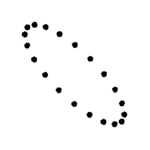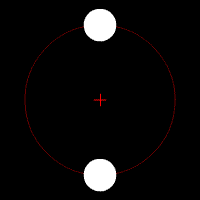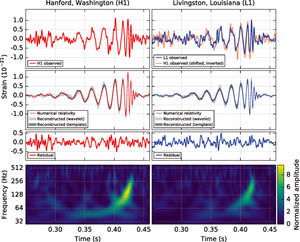موجة ثقالية Gravitational wave
| النسبية العامة |
|---|
 |
الأمواج الثقالية Gravitational wave نوع من الأمواج ينتج عن الأجسام الفيزيائية المتسارعة. ز هي أمواج ذات الطاقة معينة تنتقل خلال الحقل الثقالي للزمكان .
طبقا للنسبية العامة، يمكن للثقالة أن تحدث اهتزازات او امواج ضمن الزمكان مما يسمح بنقل الطاقة. ويمكن القول ان قوة الثقالة تتغير بمرور هذه الأمواج الثقالية. بصياغة اخرى فان قوة واتجاه القوى المدية ستهتز محدثة تغيرات اهتزازية في شكل الاجسام (وليس حجمها)الموجودة في طريق هذه الأمواج.
مقدمة

آثار العبور
المصادر
Power radiated by orbiting bodies

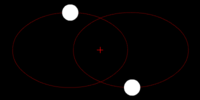
Gravitational waves carry energy away from their sources and, in the case of orbiting bodies, this is associated with an inspiral or decrease in orbit. Imagine for example a simple system of two masses — such as the Earth-Sun system — moving slowly compared to the speed of light in circular orbits. Assume that these two masses orbit each other in a circular orbit in the x–y plane. To a good approximation, the masses follow simple Keplerian orbits. However, such an orbit represents a changing quadrupole moment. That is, the system will give off gravitational waves.
Suppose that the two masses are and , and they are separated by a distance . The power given off (radiated) by this system is:
- ,[4]
where G is the gravitational constant, c is the speed of light in vacuum and where the negative sign means that power is being given off by the system, rather than received. For a system like the Sun and Earth, is about 1.5×1011 m and and are about 2×1030 and 6×1024 kg respectively. In this case, the power is about 200 watts. This is truly tiny compared to the total electromagnetic radiation given off by the Sun (roughly 3.86×1026 watts).
In theory, the loss of energy through gravitational radiation could eventually drop the Earth into the Sun. However, the total energy of the Earth orbiting the Sun (kinetic energy + gravitational potential energy) is about 1.14×1036 joules of which only 200 joules per second is lost through gravitational radiation, leading to a decay in the orbit by about 1×10-15 meters per day or roughly the diameter of a proton. At this rate, it would take the Earth approximately 1×1013 times more than the current age of the Universe to spiral onto the Sun. This estimate overlooks the decrease in r over time, but the majority of the time the bodies are far apart and only radiating slowly, so the difference is unimportant in this example.
A more dramatic example of radiated gravitational energy is represented by two solar mass (M☉) neutron stars orbiting at a distance from each other of 1.89×108 m (only 0.63 light-seconds apart). [The Sun is 8 light minutes from the Earth.] Plugging their masses into the above equation shows that the gravitational radiation from them would be 1.38×1028 watts, which is about 100 times more than the Sun's electromagnetic radiation.
Orbital decay from gravitational radiation
Gravitational radiation robs the orbiting bodies of energy. It first circularizes their orbits and then gradually shrinks their radius. As the energy of the orbit is reduced, the distance between the bodies decreases, and they rotate more rapidly. The overall angular momentum is reduced however. This reduction corresponds to the angular momentum carried off by gravitational radiation. The rate of decrease of distance between the bodies versus time is given by:[4]
- ,
where the variables are the same as in the previous equation.
الفيزياء الفلكية

الكشف عن الأمواج الثقالية
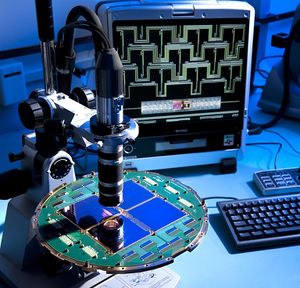
في الحقيقة ان دخول الأمواج الثقالية لأي مختبر يؤدي إلى اهتزاز جميع الاجسام فيه . فتشوهات الزمكان تؤدي إلى اضطرابات اهتزازية في جميع الأجسام المعترضة لها سيما اذا كانت ذات حجم مناسب مثل بعض القضبان المعدنية أو البلورات . تستخدم بشكل خاص قضبانا مصنوعة من الياقوت الصافي بجم ذراع الانسان مرتبطة بكواشف قادرة على كشف اهتزلزات بقطر الذرة. و هناك العديد من التجارب يستعمل فيها تقنية التداخل الليزري laser interferometry لمحاولة رصد هذه الأمواج. إلا أن قياسا مباشر لهذه الموجات مازال متعذرا إلى اليوم. غير أن علماء تمكنوا من البرهنة على وجود هذه الموجات و بذلك تأكيد نظرية أينستاين من خلال تفسيرهم لحركة نجمين توأمين عن طريق نظرية الأمواج الثقالية و مقارنة حساباتهم النظرية على أساس هذه النظرية مع ملاحظتهم لحركة النجمين.
تاريخ
- On 17 March 2014, astronomers at the Harvard–Smithsonian Center for Astrophysics erroneously claimed that they had detected and produced "the first direct image of gravitational waves across the primordial sky" within the cosmic microwave background, providing flawed evidence for inflation and the Big Bang.[8][9][1][5][2][3] On 19 June 2014, lowered confidence in confirming the cosmic inflation findings was reported[10][11][12] and on 19 September 2014, a further reduction in confidence was reported.[13][14] On 30 January 2015, even less confidence yet was reported;[15][16] Nature went as far as publishing a news article entitled "Gravitational waves discovery now officially dead".[7]
- A study published in 2016 proposed that dark energy may distort gravitational waves, and cites this circumstance as a reason for a lack of direct detection.[17]
- In February 2016, the Advanced LIGO team announced that they had detected gravitational waves from a black hole merger about 400 megaparsecs (1.3 billion light-years) from Earth.[18][19][20] The signal sweeps upwards in frequency from 35 to 250 Hz with a peak gravitational-wave strain of 1 × 10 -21.[19]
صعوبات
Gravitational waves are not easily detectable. When they reach the Earth, they have a small amplitude, meaning that an extremely sensitive detector is needed, and that other sources of noise can overwhelm the signal.[21] Gravitational waves are expected to have frequencies 10−16 Hz < f < 104 Hz.[22]
Ground-based interferometers
Though the Hulse-Taylor observations were very important, they give only indirect evidence for gravitational waves. A more conclusive observation would be a direct measurement of the effect of a passing gravitational wave, which could also provide more information about the system that generated it. Any such direct detection is complicated by the extraordinarily small effect the waves would produce on a detector. The amplitude of a spherical wave will fall off as the inverse of the distance from the source (the 1/R term in the formulas for h above). Thus, even waves from extreme systems like merging binary black holes die out to very small amplitude by the time they reach the Earth. Astrophysicists expect that some gravitational waves passing the Earth may be as large as h ≈ 10−20, but generally no bigger.[23]
A simple device theorised to detect the expected wave motion is called a Weber bar — a large, solid bar of metal isolated from outside vibrations. This type of instrument was the first type of gravitational wave detector. Strains in space due to an incident gravitational wave excite the bar's resonant frequency and could thus be amplified to detectable levels. Conceivably, a nearby supernova might be strong enough to be seen without resonant amplification. With this instrument, Joseph Weber claimed to have detected daily signals of gravitational waves. His results, however, were contested in 1974 by physicists Richard Garwin and David Douglass. Modern forms of the Weber bar are still operated, cryogenically cooled, with superconducting quantum interference devices to detect vibration. Weber bars are not sensitive enough to detect anything but extremely powerful gravitational waves.[24]
MiniGRAIL is a spherical gravitational wave antenna using this principle. It is based at Leiden University, consisting of an exactingly machined 1150 kg sphere cryogenically cooled to 20 mK.[25] The spherical configuration allows for equal sensitivity in all directions, and is somewhat experimentally simpler than larger linear devices requiring high vacuum. Events are detected by measuring deformation of the detector sphere. MiniGRAIL is highly sensitive in the 2–4 kHz range, suitable for detecting gravitational waves from rotating neutron star instabilities or small black hole mergers.[26]
Gravitational wave detection, 2016
On 11 February 2016, the LIGO collaboration announced the detection of gravitational waves, from a signal detected at 10.51 GMT on 14 September 2015[27] of two black holes with masses of 29 and 36 solar masses merging together around 1.3 billion light years away. The mass of the new black hole obtained from merging the two was 62 solar masses. Energy equivalent to 3 solar masses was emitted as gravitational waves.[28] The signal was seen by both LIGO detectors, in Livingston and Hanford, with a time difference of 7 milliseconds due to the angle between the two detectors and the source. The signal came from the Southern Celestial Hemisphere, in the rough direction of (but much further away than) the Magellanic Clouds.[18] The confidence level of the discovery was 99.99994 %.[28]
انظر أيضاً
- General Relativity
- Linearised Einstein field equations
- Gravitomagnetism
- LIGO, VIRGO, GEO 600, and TAMA 300 — Gravitational wave detectors
- LISA the proposed Laser Interferometer Space Antenna.
- Big Bang Observer (BBO), proposed successor to LISA.
- Sticky bead argument, for a physical way to see that gravitational radiation should carry energy.
- pp-wave spacetime, for an important class of exact solutions modeling gravitational radiation.
- Hawking Radiation, for gravitationally induced electromagnetic radiation from black holes
- Spin-flip, a consequence of gravitational wave emission from binary supermassive black holes.
- Gravitational field
المصادر
- ^ أ ب ت "BICEP2 2014 Results Release". National Science Foundation. 17 March 2014. Retrieved 18 March 2014.
{{cite web}}: Cite uses deprecated parameter|authors=(help) - ^ أ ب ت Clavin, Whitney (17 March 2014). "NASA Technology Views Birth of the Universe". NASA. Retrieved 17 March 2014.
- ^ أ ب ت Overbye, Dennis (17 March 2014). "Detection of Waves in Space Buttresses Landmark Theory of Big Bang". New York Times. Retrieved 17 March 2014.
- ^ أ ب Gravitational Radiation
- ^ أ ب "First Direct Evidence of Cosmic Inflation". www.cfa.harvard.edu. Harvard-Smithsonian Center for Astrophysics. 17 March 2014. Retrieved 17 March 2014.
- ^ Overbye, Dennis (24 March 2014). "Ripples From the Big Bang". New York Times. Retrieved 24 March 2014.
- ^ أ ب Cowen, Ron (2015-01-30). "Gravitational waves discovery now officially dead". nature. doi:10.1038/nature.2015.16830.
{{cite news}}:|access-date=requires|url=(help) - ^ قالب:Cite serial
- ^ Ian Sample. "Gravitational waves turn to dust after claims of flawed analysis". the Guardian.
- ^ Overbye, Dennis (19 June 2014). "Astronomers Hedge on Big Bang Detection Claim". New York Times. Retrieved 20 June 2014.
- ^ Amos, Jonathan (19 June 2014). "Cosmic inflation: Confidence lowered for Big Bang signal". BBC News. Retrieved 20 June 2014.
- ^ Ade, P.A.R. (BICEP2 Collaboration); et al. (19 June 2014). "Detection of B-Mode Polarization at Degree Angular Scales by BICEP2" (PDF). Physical Review Letters. 112: 241101. arXiv:1403.3985. Bibcode:2014PhRvL.112x1101A. doi:10.1103/PhysRevLett.112.241101. PMID 24996078. Retrieved 20 June 2014.
{{cite journal}}: External link in|format= - ^ Planck Collaboration Team (19 September 2014). "Planck intermediate results. XXX. The angular power spectrum of polarized dust emission at intermediate and high Galactic latitudes". ArXiv. arXiv:1409.5738. Bibcode:2014arXiv1409.5738P. Retrieved 22 September 2014.
- ^ Overbye, Dennis (22 September 2014). "Study Confirms Criticism of Big Bang Finding". New York Times. Retrieved 22 September 2014.
- ^ Clavin, Whitney (30 January 2015). "Gravitational Waves from Early Universe Remain Elusive". NASA. Retrieved 30 January 2015.
- ^ Overbye, Dennis (30 January 2015). "Speck of Interstellar Dust Obscures Glimpse of Big Bang". New York Times. Retrieved 31 January 2015.
- ^ "Dark Energy May Be Distorting Our View of Gravitational Waves". MotherBoard. 2016.
- ^ أ ب خطأ استشهاد: وسم
<ref>غير صحيح؛ لا نص تم توفيره للمراجع المسماةDiscovery 2016 - ^ أ ب خطأ استشهاد: وسم
<ref>غير صحيح؛ لا نص تم توفيره للمراجع المسماةAbbot - ^ خطأ استشهاد: وسم
<ref>غير صحيح؛ لا نص تم توفيره للمراجع المسماةNSF - ^ "Noise and Sensitivity". gwoptics: Gravitational wave E-book. University of Birmingham. Retrieved 10 December 2015.
- ^ Thorne, Kip S. (1995). "Gravitational Waves". arXiv:gr-qc/9506086.
{{cite journal}}: Cite journal requires|journal=(help) - ^ David G. Blair (Ed.) (1991). The detection of gravitational waves. Cambridge University Press.
- ^ For a review of early experiments using Weber bars, see Levine, J. (April 2004). "Early Gravity-Wave Detection Experiments, 1960–1975". Physics in Perspective (Birkhäuser Basel). 6 (1): 42–75. Bibcode:2004PhP.....6...42L. doi:10.1007/s00016-003-0179-6.
- ^ "MiniGRAIL, the first spherical gravitational wave detector".
- ^ de Waard, Arlette (July 2000). "Spherical Gravitational Wave Detectors: cooling and quality factor of a small CuAl6% sphere" (PDF) in Marcel Grossmann meeting on General Relativity.: 1899–1901, Rome, Italy: World Scientific Publishing Co. Pte. Ltd.. doi:10.1142/9789812777386_0420.
- ^ "Gravitational waves from black holes detected". BBC News. 11 February 2016.
- ^ أ ب LIGO’s First-Ever Detection of Gravitational Waves Opens a New Window on the Universe
- Chakrabarty, Indrajit, "Gravitational Waves: An Introduction". arXiv:physics/9908041 v1, Aug 21, 1999.
- Landau, L. D. and Lifshitz, E. M., The Classical Theory of Fields (Pergamon Press),(1987).
- Will, Clifford M., The Confrontation between General Relativity and Experiment. Living Rev. Relativity 9 (2006) 3.
ببليوگرافيا
- Berry, Michael, Principles of cosmology and gravitation (Adam Hilger, Philadelphia, 1989). ISBN 0-85274-037-9
- P. J. E. Peebles, Principles of Physical Cosmology (Princeton University Press, Princeton, 1993). ISBN 0691019339.
- Wheeler, John Archibald and Ciufolini, Ignazio, Gravitation and Inertia (Princeton University Press, Princeton, 1995). ISBN 0-691-03323-4.
- Woolf, Harry, ed., Some Strangeness in the Proportion (Addison-Wesley, Reading, Massachusetts, 1980). ISBN 0201099241.
وصلات خارجية
- Caltech's Physics 237-2002 Gravitational Waves by Kip Thorne Video plus notes: Graduate level but does not assume knowledge of General Relativity, Tensor Analysis, or Differential Geometry; Part 1: Theory (10 lectures), Part 2: Detection (9 lectures)
- www.astronomycast.com January 14, 2008 Episode 71: Gravitational Waves
- Laser Interferometer Gravitational Wave Observatory. LIGO Laboratory, California Institute of Technology.
- Einstein's Messengers - The LIGO Movie by NSF
- Home page for Einstein@Home project, a distributed computing project processing raw data from LIGO Laboratory, searching for gravity waves
- The National Center for Supercomputing Applications -- a numerical relativity group
- Caltech Relativity Tutorial -- A basic introduction to gravitational waves, and astrophysical systems giving off gravitational waves
- Resource Letter GrW-1: Gravitational waves -- a list of books, journals and web resources compiled by Joan Centrella for research into gravitational waves
- Mathematical and Physical Perspectives on Gravitational Radiation -- written by B F Schutz of the Max Planck Institute explaining the significance and background of some key concepts in gravitational radiation
- Binary BH Merger -- estimating the radiated power and merger time of a BH binary using dimensional analysis



